
Official Edgar Rice Burroughs Tribute and Weekly Webzine Site
Since 1996 ~ Over 15,000 Webpages in Archive
Volume 0449
presents

|
"Nkima scolded and chattered from the safety of his master's shoulder ..." (Invincible)
|
Burroughs began working on this 25 chapter story in February of 1914, three days after The Beasts of Tarzan was finished. It is a 40,000 word novelette with the working title “Men and Beasts.” It was serialized in three parts in All-Story Weekly (June 30; July 7, 14, 1917.)


![]()
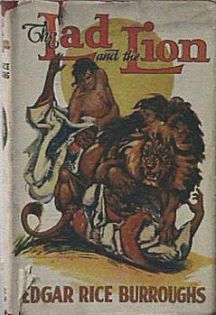
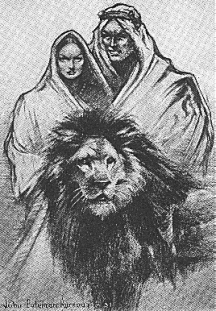

 |
Chapter Summaries 1-4 Chapter One
Chapter Two
Chapter Three
Chapter Four
The old man recovers and begins beating the boy with the whip and the iron pipe. The lion breaks out of the rusty cage, tears the face off the wicked old man, and eats him. The lion invites the boy to share in the feast, but he throws the corpse overboard. We are now informed that in the past, the old man had been forgotten and left aboard the ship when everyone else had jumped off during a fire that threatened to blow up the gunpowder aboard. He had plenty of food and water, so he had just drifted around torturing the lion cub until it became full grown. The lad came aboard later. The lad and the lion drift around for six months after the death of the old man. Finally, the ship reaches land, and the lad and the lion face a new world of unguessed romance and adventure. |
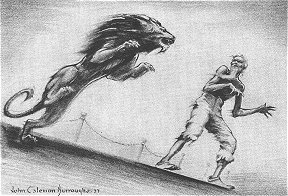
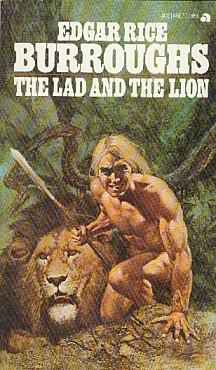

![]()
An Essay on The Fourth Chapter of Lad and the LionWhy did ERB write the Lad and the Lion when he had just finished The Beasts of Tarzan, which is usually judged to be a more successful story? What work did he feel was left unfinished? Perhaps Burroughs was trying his hand at a movie script, for “The Lad and the Lion” was given a film treatment, in fact, ERB’s first ever.
“In late 1914 the author mailed a copy of Tarzan of the Apes, along with the unpublished “The Lad and the Lion,” to Colonel William N. Selig, president of the Selig Polyscope Company in Chicago. Selig was a pioneer in the silent film era, producing many wild animal films from his studios in Los Angeles; Chicago; and Prescott, Arizona. Interesting enough, it was “The Lad and the Lion,” rather than the original Tarzan story, that Selig chose to produce. Released in May 1917, the film was about the exciting adventures of a young man and a lion who are shipwrecked together in Africa and who become close companions.” (Fury, 8).
Chapter Four of this story contain one of the most amazing fairy tales ERB ever penned. The feral child theme is given a new slant, and the author presents one of his best tales, which may be considered as a stand-alone wondertale full of dramatic irony and suspense with quite a startling conclusion.
In this tale we stand for a moment at the threshold of one of the best writers of 20th Century fiction. We are in the presence of Franz Kafka; if not entirely before a complete Metamorphosis, at least the spirit his Penal Colony is evoked. It seems we have a bit of both of these stories in this wonderful tale that reaches into the world of the parable with such stunning force. It is interesting to note that Kafka was writing his tales at the same time, so it is not possible that there was any influence on Burroughs, but a fleeting observation of a rough correspondence of themes is not out of place. Both writers worked from an inner nightmare world that was most likely informed by the German folk tales of the Brothers Grimm.
What is the strange fairy tale of the Lad and the Lion?
Once upon a time a boy lived in a garden with his grandfather king. His father was dead, and he lived in great danger from enemies on every side. One day the boy’s grandfather went out riding, and he too was killed. The lad was whisked away by a man who put him aboard a great ship that quickly became lost in a storm. In time the boy found himself aboard another ship where everything was new and changed, and he no longer knew who he was. He could not speak a word, for he had forgotten how to talk. On board this strange floating world, the lad met a deaf-mute old man who was cruel to him and cruel as well to a lion that was kept in an iron cage. Having no comfort in this nightmare, the lad made friends with the lion. The lad and the lion sailed aboard the drifting derelict for years. All curious strangers were kept away by a smallpox flag on the mast head. The old man made the lad change the name and the color of the ship after each encounter with another ship. Without a memory, the boy thought that this was the only possible form and manner of life. He thought all ships held cruel old men and lions and boys.
The old man taught the boy a rude sign language, and the boy tried to teach it to the lion. The lion cannot learn the signs, but the boy learned to communicate with the lion by a kind of thought transference. The lad learned to purr and roar like a lion, but the deaf-mute old man could not hear this. The lad has become more of a lion than a man.This situation lasts for four years as the boy grows into the strength of young manhood. The old man beats his naked body with a heavy leather whip to keep him in his place. One day a ship passes by close enough so that the lad can see men, women, and children. The naked boy waves and roars like a lion! The officer on the bridge calls to them over a megaphone, but no one aboard can understand him! The old man shrieks and gibbers at the boy and signals him to go below, but he resists, striking the old man, who falls into a sudden fit of epilepsy. The other ship finally goes away, frightened off by the smallpox flag. The old man recovers and begins beating the boy with the whip and an iron pipe. The lion breaks out of the rusty cage, tears the face off the wicked old man, and eats him. The lion invites the boy to share in the feast, but he only throws the corpse overboard. The lad and the lion drift around for six months after the death of the old man. Finally, the ship reaches land, and the lad and the lion face a new world of unguessed romance and adventure.
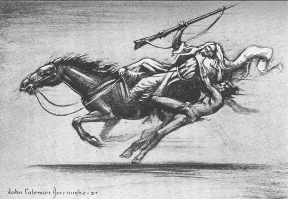
Exegesis
That the lad was really a Prince does not matter, for are not all children secretly the sons and daughters of some royal family far away? It does not even matter that the boy is brave and offers himself to the sea so that women and children might be saved in the storm. Nothing that ever happened to him in the past matters at all because soon he will lose his memory of everything. Yes, he will lose everything, his name, his personality, his entire humanity. He will be a blank slate to be drawn upon by a madman as he drifts upon a ship of madness throughout an endless world of empty seas.
There are three wanderers aboard this ship of forgetfulness. All of them have lost their former worlds.
The boy is an orphan, for he has lost his parents, but he is an orphan to speech as well. In fact, the boy is an orphan to humanity itself. He is the ultimate castaway. No one could ever be more alone than this lad.
The old man is a deaf-mute, who is also quite insane, and an epileptic as well. The lion has been caged since he was a cub; he is a mirror of the boy.
The lad is in a worse position than even Tarzan of the Apes, for he has no Kala to comfort him. He only has the lion, yet even this beast is locked behind bars that serves as a barrier to his becoming a lion child. However, the lad does somehow learn the language of the lion. They are linked by a common captivity in a world that is controlled by madness and pain.
The old man teaches the boy a rude form of sign language, and the boy tries to teach it to the lion. There is both irony and great sadness in the attempt.
Both the lad and the lion are beaten by the old man. It is their point of commiseration. The lion has as little chance at becoming a feral boy as the boy has at becoming a lion. They purr and roar out their limited understanding to each other.
The wild calls to the wild; the beast in the boy touches the beast in the cage. They are one in spirit, but that spirit is an animal’s, not man’s.
The lad thinks that the whole world consists of ships and cruel old men and lions in cages.
We come to believe this could possibly be a true picture of the world because it has become the truth of the world for the boy. Perhaps we are all the captives of a mad man god whom we can never understand and who can never understand us. We can only make rude signs to each other, and his only response is to punish us again and again.
There is a great beast aboard our wandering ship, one we can communicate with through our love alone. Yet this beast is caged and is suffering as much as we are. He is our salvation, but we do not know this because we cannot touch the meaning of something that is locked away from our understanding.
When another ship passes nearby and they call to them, the old man cannot hear the words. Both the boy and the lion can hear, but neither of them understands the words. The boy roars to the passing ship in a scene of irony pressed upon irony. He is communicating in the only way he knows how, yet the men and women of his own race can only hear his beastly growls. They do not understand the roaring of his pain.
The situation is so extreme that it is almost beyond tears or laughter.
Suddenly the lion is loosed upon this world of madness. The beast kills the old man and devours him. The lion offers the body of the old man to the boy to feed upon, but he only takes part in the feast of revenge, casting the empty corpse into the sea. Whether we devour the old man or not, he is gone. His pain -- all pain has been eaten by the lion.
They are set upon a new shore -- a lad and a lion. The beast is our one true friend. We step into a brave new world where anything is possible. All old things are passed away; behold all things have become new.
We are prepared for a Revelation.
Rev: 21:1 “And I saw a new heaven and a new earth: for the first heaven and the first earth were passed away; and there was no more sea.”
Rev: 21:4 “And God shall wipe away all tears from their eyes; and there shall be no more death, neither sorrow, nor crying, neither shall there be any more pain: for the former things are passed away.”
After this beginning, the tale spins off into ERB’s formula story, which reduces the wonder to just another pulp fiction offering. Or does it?
The “minor stories” of ERB sometimes contain episodes of major importance that can be uncovered by a careful reading. It would make a great project to uncover all of these fragments of genuine inspiration. One might begin with Chapter 8 and 9 of A Fighting Man of Mars. The fairy tale is called “The Spider Of Ghasta.”
Perhaps ERB wrote so many of these little tales because he needed to present something interesting each week in the magazine format in which he was first offering his longer novels. These haunting fairy tales are often hidden within the larger structure. Perhaps this is true because Burroughs’ dreamed his novels rather than constructing them. His overall novelistic formula was already in place, and he used it again and again. The variety of his work came in the depth of his imaginative dreaming that flowed out of his pen that was connected with the mind and heart of a story-telling shaman.
“Whoever speaks in primordial images speaks with a thousand voices; he enthralls and overpowers, while at the same time he lifts the idea he is seeking to express out of the occasional and the transitory into the realm of the ever-enduring. He transmutes our personal destiny into the destiny of mankind, and evokes in us all those beneficent forces that ever and anon have enabled humanity to find a refuge from every peril and to outlive the longest night.” (Jung 82).
ERB was not a great experimenter in the form of the novel, but in the presentation of vivid dreams and fairy tales, he was one of the best.
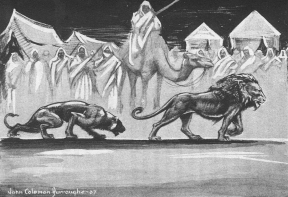
![]()

Bibliography
Burroughs, Edgar Rice, The Lad and the Lion, Canaveral, 1964.
Fury, David, Kings of the Jungle, McFarland, 1994.
Jung, Carl, The Spirit in Man, Art, and Literature, Bollingen Series XX, Princeton, 1978.
St. John, The Book of Revelation, The Holy Bible.
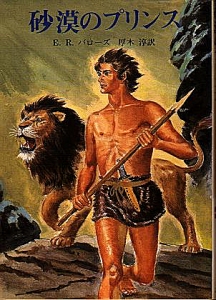
|
ERBzine 0450 takes a look at ERB's FIRST FILM |
![]()
![]()
Volume
0449
![]()

![]()
BILL
HILLMAN
Visit
our thousands of other sites at:
BILL
AND SUE-ON HILLMAN ECLECTIC STUDIO
All
ERB Images© and Tarzan® are Copyright ERB, Inc.- All Rights Reserved.
All
Original Work © 1996-2006/2019 by Bill Hillman and/or Contributing
Authors/Owners
No
part of this web site may be reproduced without permission from the respective
owners.